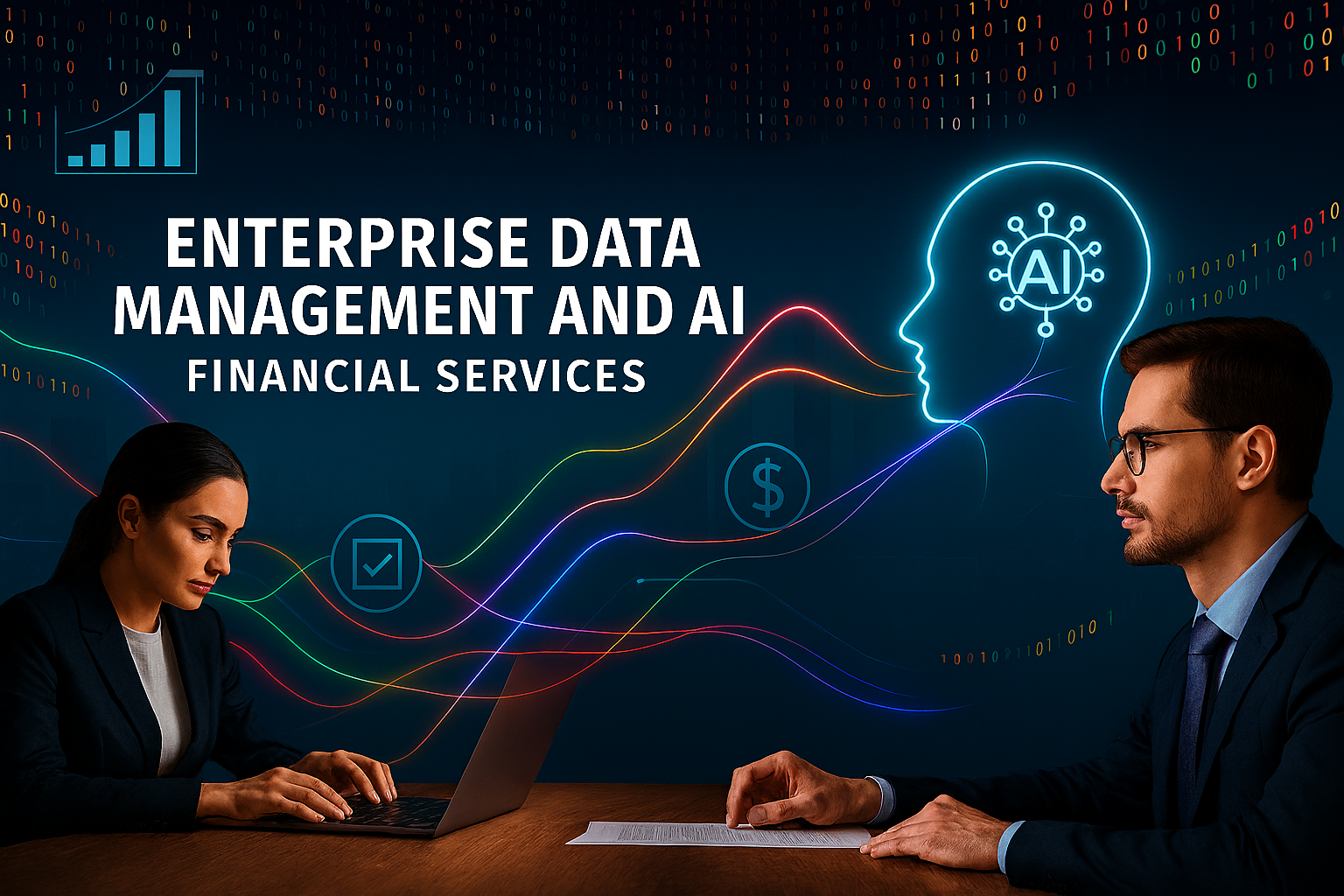Harnessing Enterprise Data Management and AI in Financial Services

Enterprise Data Management and AI in the financial services industry is undergoing a profound transformation driven by data proliferation, regulatory complexity, and the demand for real-time insights. Innovative platforms enable financial institutions to adopt a “one-to-many” approach to artificial intelligence (AI). This strategy involves deploying centralized AI and data infrastructure that can serve multiple business functions, thereby maximizing efficiency, scalability, and return on investment.
This summary explores how both vendors implement this approach, the practical applications of AI with human-in-the-loop (HITL) mechanisms, and real-world use cases that demonstrate the value of these solutions.
Understanding the ‘One-to-Many’ AI Strategy
The “one-to-many” approach refers to the capabilities of scalable AI and data via platform(s) that can support multiple use cases, departments, and workflows across an organization. Instead of building siloed solutions for each business need, financial institutions can leverage a unified infrastructure to:
- Centralize data from disparate sources.
- Deploy reusable AI techniques and sometimes multiple models and LLMs across functions.
- Enable real-time analytics and decision-making.
- Ensure compliance and governance across the enterprise.
This model is particularly effective in financial services, where data complexity, regulatory scrutiny, and operational efficiency are paramount.
AI-Driven Data Modernization
More and more firms specialize in native data and AI solutions tailored for financial services. Their platform enables organizations to build centralized data lakes, automate workflows, and deploy AI assistants across multiple domains.
Key Capabilities
- Metadata-Driven Analytics: uses metadata to streamline. For example in insurance analytics, underwriting, and claims processing.
- AI Assistants (LLMs): For example, automates document handling and supports customer service agents.
- Cost Optimization: Intelligent data architecture reduces cloud costs and improves performance. For example, pricing mechanisms and recommendations
- Customer Experience Modernization: For example, link using Model Context Protocols the CRM tool integrates data systems from Operations and Chief Investment Officer departments to deliver real-time dashboards and insights.
One-to-Many in Action
Centralized data infrastructure allows institutions to deploy AI models across:
- Risk and compliance (e.g., fraud detection).
- Customer onboarding (e.g., KYC automation).
- Claims processing (e.g., document parsing).
- Marketing and personalization (e.g., product recommendations).
This reuse of infrastructure and models exemplifies the one-to-many strategy.
Enterprise Data Management
AI enablement can offers a unified, trusted data foundation for investment firms. It is designed to centralize, standardize, and virtualize data across the enterprise, enabling real-time operations and AI integration.
Key Capabilities
- Unified Data Model: Centralizes data for consistency, accuracy, and transparency
- Real-Time Dashboards: Supports instant retrieval and contextual analysis.
- Data Virtualization: Enables integration with internal and external systems.
- Automated Workflows: Streamlines data ingestion, transformation, and publishing.
- Entitlement-Aware Architecture: Ensures secure, role-based access to data.
One-to-Many in Action
A platform supporting multiple use cases from a single data foundation:
- Investment & Distribution operations (e.g., Corporate Actions, cost centre P&L calculation, Vendor Management triage, RFP responses).
- Compliance and audit readiness. AI governance and security
- Asset onboarding and lifecycle management.
- Risk and performance analytics. Know the data problems at the start of the process, not part way or at the end of a cycle
Its AI-first architecture and integration with multiple AI agents enable intelligent automation across departments to provide scale and process automation. Humans are always in the loop.
Some vendors emphasize centralization, scalability, and interoperability. Some vendors lean towards AI-driven automation. Others towards data governance and operational control.
Few vendors can combine all of these. infin8 believe there is an opportunity
Practical Use of AI with Humans in the Loop
AI in financial services must operate within a framework of human oversight to ensure ethical, accurate, and compliant outcomes.
Customer Client Communication and Investment Reporting
- AI Role: heavy lift process automation, interface between silos
- Human Role: Reviews, augments, refines, corporate voice
Document Processing and Claims Automation
- AI Role: Extracts data, applies rules, flags anomalies.
- Human Role: Validates decisions, handles exceptions.
Investment Data Management
- AI Role: Automates reconciliations, monitors data quality.
- Human Role: Oversees data lineage, resolves discrepancies.
Regulatory Compliance
- AI Role: Tracks regulatory changes, generates reports.
- Human Role: Interprets regulations, ensures alignment.
Customer Onboarding and KYC
- AI Role: Verifies identity, scores risk.
- Human Role: Reviews flagged cases, ensures fairness.
Asset Onboarding and Lifecycle Management
- AI Role: Defines asset characteristics, updates models.
- Human Role: Approves configurations, monitors impact.
Strategic Recommendations for Financial Institutions
To adopt a one-to-many AI strategy
- Build a Unified Data Foundation
- Use AI-native architecture.
- Centralize data sources for consistency and transparency.
- Deploy Multiple Reusable AI Models
- Train models for document parsing, fraud detection, and onboarding.
- Reuse across departments to maximize ROI.
- Integrate Human-in-the-Loop Workflows
- Design interfaces for human validation and feedback.
- Ensure compliance and ethical oversight.
- Automate Operational Processes
- Shadow a function. Help humans to adopt and adopt to working with AI. Process automation and offsourcing left some scars. But it was also transformational.
- Streamline data ingestion, transformation, exception reporting and reporting.
- Monitor and Optimize Continuously
- Track performance, meter costs, and accuracy.
- Use dashboards and alerts to manage exceptions.
Conclusion
The integration of AI into enterprise data management platforms transformative shift in how financial institutions manage, analyze, and act on data. A ‘one-to-many’ AI approach—where a single AI agent serves multiple users, systems, and use cases—offers scalability, consistency, and intelligence across the enterprise.
By embedding AI into data stewardship, compliance, workflow orchestration, and decision support, firms can unlock new efficiencies and insights. However, the Human-in-the-Loop model remains essential to ensure trust, compliance, and continuous improvement.
As platforms continue to evolve with agentic AI capabilities and real-time data access, the future of enterprise data management will be defined by intelligent collaboration between humans and machines—turning data into a strategic asset for growth, resilience, and innovation. Of course, experience learning can not be replicated, it takes time. Don’t wait around.
more reading
Enterprise Information Management: What it Means, How it Works
